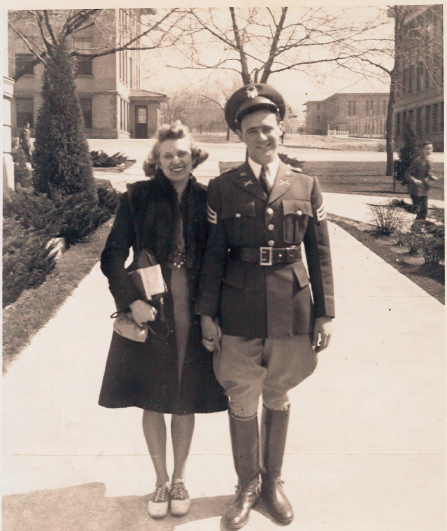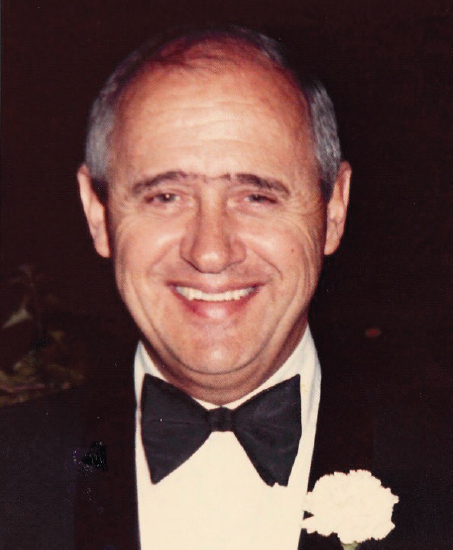

WILLIAM R. GOULD
1919–2006
Elected in 1973
“Contributions and leadership in fossil fuel and nuclear power developments, siting, environmental impact, and water desalinization.”
BY WAYNE R. GOULD
SUBMITTED BY THE NAE HOME SECRETARY
WILLIAM RICHARD GOULD was born on Halloween in 1919 in Provo, Utah. He was born at home, in an adobe house, to Pauline Eva (née Feser) and William John Gilbert Gould. His father was a steam locomotive engineer for the Utah Railway.
As a child, Bill stuttered badly. To avoid being the target of youthful pranks and ostracism he became a loner, independent and determined to succeed. Sensing his loneliness, his father began taking him to work on the railroad. Bill often rode on his father’s lap in the big steam locomotive and before long fell in love with this world of fuel and steel, fire and steam, motion and power.
When he came of age, he enrolled at the University of Utah as an engineering student. On one of his first days a counselor, noticing his speech impediment, told him that he could never be successful as an engineer and suggested he should drop out of school and go back to the family farm. Bill resolutely told the counselor that there wasn’t a family farm to go back to, so he “guessed” he would stay and give it a try. He completed his bachelor’s degree in mechanical engineering in 1942 and went on to become a registered professional engineer in California and Utah.
While at the university he met his future wife, Erlyn Arvilla Johnson. A childhood illness had left her with the fragile body
of a “China Doll.” But this China Doll had the heart of a lion and a fierce independent determination, bred of poverty, to live life to its fullest and not ask for any favors. They were an equal pair—two tough kids from poor backgrounds and with personal challenges but an indomitable spirit. They were married March 20, 1942, in the Salt Lake City Temple of the Church of Jesus Christ of Latter-day Saints. Together they would face adventure, excitement, and hardship. They lived successfully and they lived well. Their marriage clearly demonstrated that the whole far exceeded the sum of the parts.
As an ensign in the US Naval Reserve, Bill was sent to the Massachusetts Institute of Technology and Dartmouth University for graduate courses in engineering. After this advanced training, he was stationed at the Long Beach Naval Shipyards, where he served throughout World War II as a trials officer in charge of testing the propulsion machinery of ships before their departure for war zones.
His wartime experience qualified him for postwar employment with the Southern California Edison Company (Edison) in Los Angeles and then nearby Rosemead. In 1948 it was a hydroelectric utility that was just beginning to transition to thermal generation; it needed someone who knew something about fuel and steel, fire and steam, motion and power.
Bill worked for Edison for 44 years. Its prosperity was his prosperity and that of his family. The company grew into a world-class utility renowned for energy innovation and the application of cutting-edge technologies. As the company grew, Bill assumed positions of increasing responsibility and authority, becoming president in 1978 and chair and chief executive officer in 1980. When he retired in 1984 he was designated chair of the board emeritus and consultant to the management, remaining involved in the company until 1992.
Bill and Edison were inextricably connected, and many suggested that he was the heart and soul of the enterprise. In recognition of his exceptional career, in 1992 Southern California Edison created the William R. Gould Award for Engineering and Operational Excellence, presented annually to two outstanding employees.
Bill may be best remembered for his pioneering work in the development, sponsorship, and acceptance of alternative and renewable energy. In the early 1980s he informed employees that Edison’s policy was “to devote our corporate resources to the accelerated development of a wide variety of future electrical power sources which are renewable rather than finite.” He called on employees to develop alternative sources such as windmills, solar panels, and fuel cells, and opened the door to the acceptance of third-party independent power producers. Among large-scale projects, he helped lead the construction of the Pacific Intertie, a major electricity transmission line linking Southern California to the Pacific Northwest, and the San Onofre Nuclear Generating Station, a 2200-megawatt power station in San Diego County.
For its forward-looking advances, in 1982 the company was awarded the Tyler Prize for Environmental Achievement, cited as “the first major utility in the United States to establish as policy a shift to alternate and renewable energy sources [and with] strong corporate leadership.” At the time of Bill’s passing, nearly a fifth of Edison’s electricity was provided through renewable sources—more than any other major utility, according to the company.
Bill’s efforts would change the utility industry forever. As he said in a 1981 Forbes interview, “If a species doesn’t go through a mutation to meet its new environment, it doesn’t survive. A corporation is in the same situation.”
In addition to his work at Edison, Bill was active in a variety of other capacities. He chaired the Atomic Industrial Forum, Electric Power Research Institute, National Energy Foundation, and Institute for the Advancement of Engineering, and served on the boards of the Aerospace Corporation, Beckman Instruments, Inc., and Science Applications International Corporation, among others. For the National Academies of Sciences, Engineering, and Medicine, he served on the Energy Engineering Board (1978–81 and 1985–89), chaired its Panel on the Future of Central Station Electric Power (1986–87), cochaired an ad hoc Committee on Energy Conservation Research (1985–86), and was appointed
to the high-profile Supercollider Site Evaluation Committee (1987–88).
His legacy also includes the William R. and Erlyn J. Gould Distinguished Lecture on Technology and the Quality of Life, at the University of Utah. Endowed by the couple in 1991, the annual lecture by a noted scientist or engineer focuses on technical and environmental issues.
His excellence as both an engineer and a captain of industry was well recognized. In addition to his election to the NAE in 1973, he received the George Westinghouse Gold Medal (1979), IEEE Centennial Medal (1984), Oliver Townsend Medal of the Atomic Industrial Forum (1983), California Industrialist of the Year (1985), and American Society of Mechanical Engineers Award of Recognition (1993).
To define Bill’s life in terms of his professional successes or by the positions he held in his industry, faith, or community would be to do a great injustice to his memory. His most rewarding accomplishments were at home with his wife and family. He and Erlyn raised four children: Erlyn Sharon, William Richard Jr., Gilbert John, and Wayne Raymond. As parents they were fully invested in the individual and collective success of the family, constantly encouraging their children to overcome challenges and to achieve. The couple were devout and served in many positions of responsibility in the Church of Jesus Christ of Latter-day Saints.
After witnessing the graduations and marriages of their four children and celebrating their 50th wedding anniversary, Erlyn’s China Doll body broke and, despite her leonine heart, she died in 1992. After her death, Bill renewed an acquaintanceship with Mildred (Millie) Nielsen Johnson, an elementary school classmate who in the third grade had reached out a supporting hand while Bill stuttered through a class recitation. Like Bill, Millie had lost her spouse; after a short courtship they married and lived happily together until Bill’s death March 11, 2006, at the age of 86. Bill and Erlyn are survived by their four children, 25 grandchildren, and 40 great-grandchildren.
At a retirement luncheon from Edison’s board of directors to honor Bill and his professional achievements, he was asked
to share some observations about what he had learned over an illustrious career. First he thanked everyone for the honor they had bestowed upon him. “Haven’t we all had fun!” he said. Then looking at Erlyn, he added, “Paraphrasing Emily Dickinson, all I know about love, is that love is all there is.”
Bill Gould was an incredible man, known and appreciated for his professional ability, integrity, and most of all his humanity.






